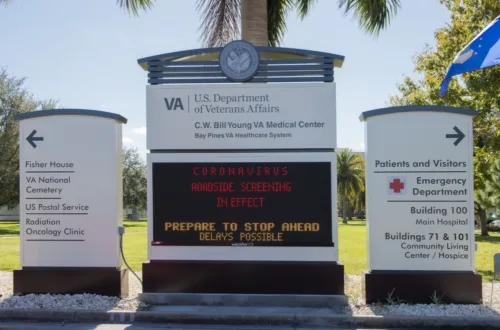PTSD Awareness Day is June 27th

PTSD Awareness Day
Post Traumatic Stress Disorder (PTSD) is a global problem. It is a mental health disorder that some people develop after experiencing a traumatizing or life-threatening event. To shed light on this far reaching problem, June 27th has been designated National PTSD Awareness Day, and it is a great opportunity to talk with family and friends about PTSD and how it affects our society, especially service members who are susceptible to it.
Who Is Affected by PTSD?
According to the PTSD Foundation of America, an estimated 7.8% of Americans will experience PTSD at some point in their lives. Women (10.4%) are twice as likely as men (5%) to develop PTSD. An estimated 3.6% of U.S. adults between the ages of 18 and 54 (over 5 million people) have PTSD during any given year.
The most traumatic events most associated with PTSD for men are rape, combat exposure, childhood neglect, and childhood physical abuse. For women, the most traumatic events associated with PTSD are rape, sexual molestation, physical attack, being threatened with a weapon, and childhood physical abuse.
Roughly 30% of the men and women who have spent time in war zones experience PTSD. Another 25% have had partial PTSD at some point in their lives. The PTSD Foundation estimates that more than half of all male Vietnam veterans and nearly half of all female Vietnam veterans have experienced “clinically serious stress reaction symptoms.” Percentages for other war veterans are not as severe, but no less important.
Key Statistics of PTSD
- Only 50% of PTSD sufferers ever seek treatment, and only half of those receive adequate treatment.
- Nearly 1,400 active duty service members committed suicide every year until 2015
- From 2003-2015, more military members died from suicide than those serving in Iraq
- In 2017, 21,290 marriages of service men and women ended in divorce, making the divorce rate for all branches 3%
What Are the Symptoms of PTSD?
While it is common to experience PTSD symptoms right after a traumatic event, PTSD is usually not diagnosed unless the symptoms last for at least a month and cause either significant distress or interfere with work/home life.
According to the National Institutes of Health, to be diagnosed with PTSD, someone must experience all of these symptoms for at least a month: Re-experiencing symptoms, avoidance & numbing symptoms, arousal symptoms, and cognition and mood symptoms.
Re-experiencing Symptoms
These are symptoms that involve reliving the traumatic event. This could happen by having upsetting memories of an event, and can come back unexpectedly. They are commonly called “flashbacks” and they can feel so real that it is like experiencing the event all over again. They can also be bad dreams or frightening thoughts. Physical symptoms of a flashback can be a racing heart or sweating. The reliving of a traumatic event can lead to intense feelings of fear and helplessness.
Avoidance & Numbing
Avoidance symptoms are those efforts people make to avoid situations that trigger memories of the traumatic event. This can be similar to avoiding fireworks because they trigger memories of explosions, or avoiding over-crowded venues because of combat experience in urban environments. Those who exhibit avoidance symptoms may avoid watching certain TV programs about events similar to those they experienced, like war movies.
Numbing symptoms are another way to avoid reliving a traumatic event. Individuals with PTSD often find it difficult to express their feelings or emotions to other people. It is common for some to forget portions of an event as they try to cope with the stress. Others fear their lives will be shorter as a result of the event.
Arousal Symptoms
These symptoms are known to cause increased emotional arousal that can lead to:
- Difficulty sleeping
- Outbursts of anger
- Irritability
- Inability to concentrate.
Some feel that they are always “on guard”, keeping an eye out for threats or signs of danger. They may also startle easily.
Cognition and Mood Symptoms
These symptoms can worsen after an event and are not due to injury or substance abuse. They can make someone feel alienated or detached from family and friends. These symptoms can include:
- Trouble remembering key events surrounding the traumatic event
- Negative thoughts about the world
- Distorted feelings like guilt or blame
- Loss of interest in enjoyable activities.
PTSD Can Lead to Other Problems
It is not uncommon for other problems to manifest alongside PTSD. Common conditions are depression, anxiety, and substance abuse. The PTSD Foundation states that more than half of men with PTSD also have problems with alcohol. The next most common condition in men is depression, followed by conduct disorders and drug abuse.
Nearly 50% of women with PTSD also suffer from depression. The next most common problems found in women are the development of specific phobias, social anxiety, and then problems with alcohol.
PTSD Treatments
The VA recommends trauma-focused psychotherapies for treating veterans with PTSD. These treatments have a duration of between 8-16 sessions. The strongest of these therapies are:
- Prolonged Exposure (PE) – teaches someone how to gain control by facing negative feelings. It involves talking about the trauma with a provider and doing some of the things you’ve avoided since the trauma
- Cognitive Processing Therapy (CPT) – teaches someone to reframe negative thoughts about the trauma. It involves talking with a provider about the trauma and completing short writing assignments.
- Eye Movement Desensitization and Reprocessing (EMDR) – helps you process and make sense of the trauma. It involves calling the trauma to mind while paying attention to a back-and-forth movement or sound, like a waving finger, a light, or a tone.
The VA also has a PTSD Treatment Decision Aid, which is a free online tool that illustrates the different treatment measures and compares them to each other. The tool also helps you think about which treatment might be best for you and gives you tips on how to work with your provider to decide on a treatment.
With the PTSD Treatment Decision Aid, you can:
- Watch videos of providers explaining how treatments work
- Build a chart to compare the treatments you like most
- Print a personalized summary
(Please note, the VA’s Decision Aid is not a substitute for medical care or the advice of a provider. Only a licensed professional can diagnose PTSD.)
Steps You Can Take
If you or someone you know is having a crisis or is experiencing symptoms of PTSD, there are a number of options available to you. These are:
- Call 911
- Go to the nearest Emergency Room
- Contact the National Suicide Prevention Line: 1.800.273.8255
- En Espanol: 1.888.628.9454
- Contact the Red Cross: 1.877.272.7337
- Contact the Veterans Crisis Line:
- 1.800.273.8255, press 1
- Send a text to 838-255
- Chat online: Confidential Veterans Chat
Remember, June 27th, is National PTSD Awareness Day. With the right information and compassion for our nation’s heroes, we can connect these life saving services to those amongst us who are stuffing from PTSD.
(Please Note: the National Center for PTSD does not provide direct clinical care or individual referrals. They provide information to help you find local mental health services and information on trauma and PTSD.)
(Image courtesy of Katarzyna Bialasiewicz via 123rf.com)
RELATED:
- Mental Health & Resilience Resources For Veterans
- Suicide Prevention Resources For Military & Veterans
- Where To Find Service Dogs For Veterans
- Telemedicine Benefits for Military and Veterans
- Organizations that Help Military Kids and Families
- Where To Find Service Dogs For Veterans
About the author
Julie Provost is a freelance writer, and blogger. She lives in Tennessee with her National Guard husband and three boys.


